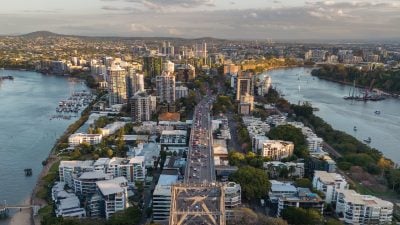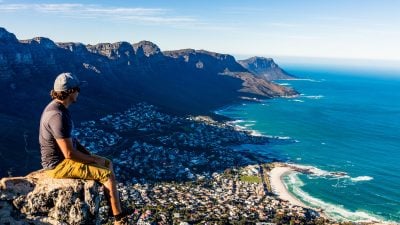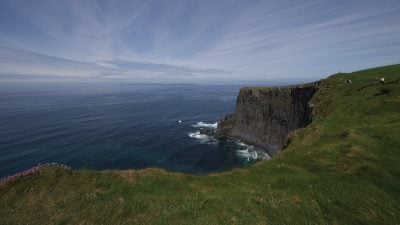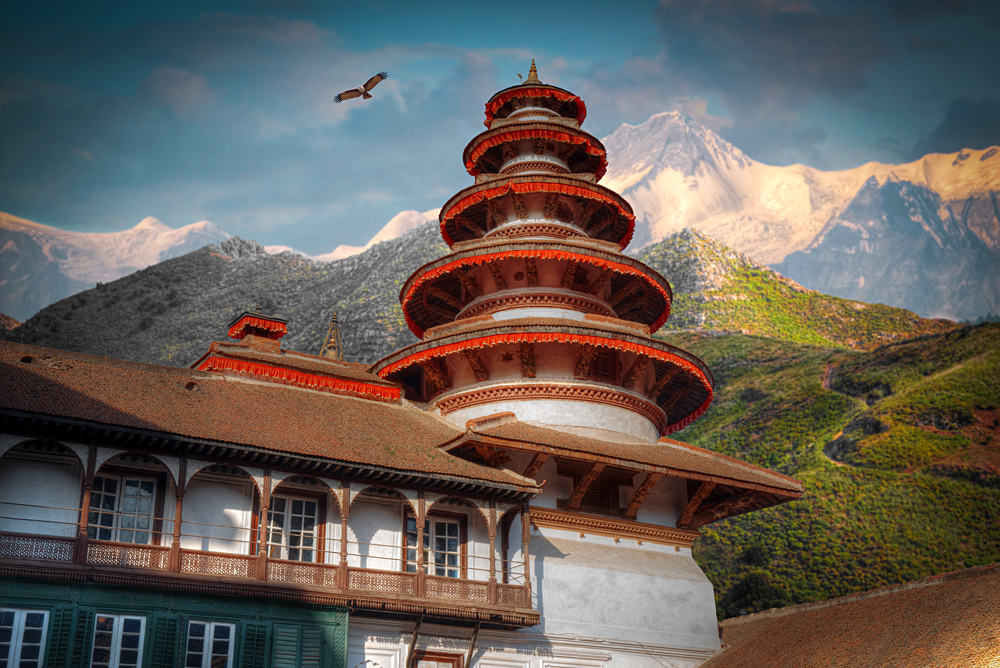
Something to Appeal to Everyone on Nepal Tours
Nepal tours offer breathtaking natural beauty, history, culture, towering mountains, serene lakes, safari parks, bird watching, trekking, adventure sports, and above all, friendly people, all waiting to greet you.
Let’s start with some facts about Nepal before getting into the attractions of a visit. It is a landlocked country sandwiched between India to the south, east and west and Tibet to the north. Geographically, it is not that large a country, being 800 kilometres/497 miles long and 200 kilometres/124 miles wide. Basically, it can be divided into 3 physical regions – these being the mountains in the north, the hills in the middle, and the lowland plains to the south. This gives a diverse range of not only landscapes but also temperatures. One interesting fact is that Nepal contains 8 out of the 10 highest mountain peaks in the world, including the one and only, Mount Everest. Another interesting fact is that it is the birthplace of Buddha, the founder of Buddhism, although the overwhelming majority of the Nepalese population is Hindu, a religion not that far removed from Buddhism.
Temples and Squares
It is usual that you would start your Nepal tours in the capital, Kathmandu. There is much to see and do in and around the city and it is recommended that you spend at least a few days here. The starting point on your stay in Kathmandu will be Durbar Square, the heart of the old city. Durbar means “royal palace” so, naturally, in the square is the old Royal Palace from the days when Nepal was a kingdom (it has been a republic since 2007). Don’t get confused with the name Durbar Square. There are 3 of them (all UNESCO World Heritage Sites) in the vicinity of Kathmandu, all providing an insight into the life and style of this ancient kingdom, but more of that later. The palace here is a mixture of eastern and western architecture. An amazing 50 temples lie within the vicinity, including the Taleju Bhawani Temple built in 1564, the square’s most magnificent temple, dedicated to a goddess of the same name from Southern India. Unfortunately, it is not open to the public except one day a year during the Dashain Festival, which lasts 15 days at the end of September through to early October. Dashain commemorates a great victory of the gods over the wicked demons and is celebrated throughout Nepal.
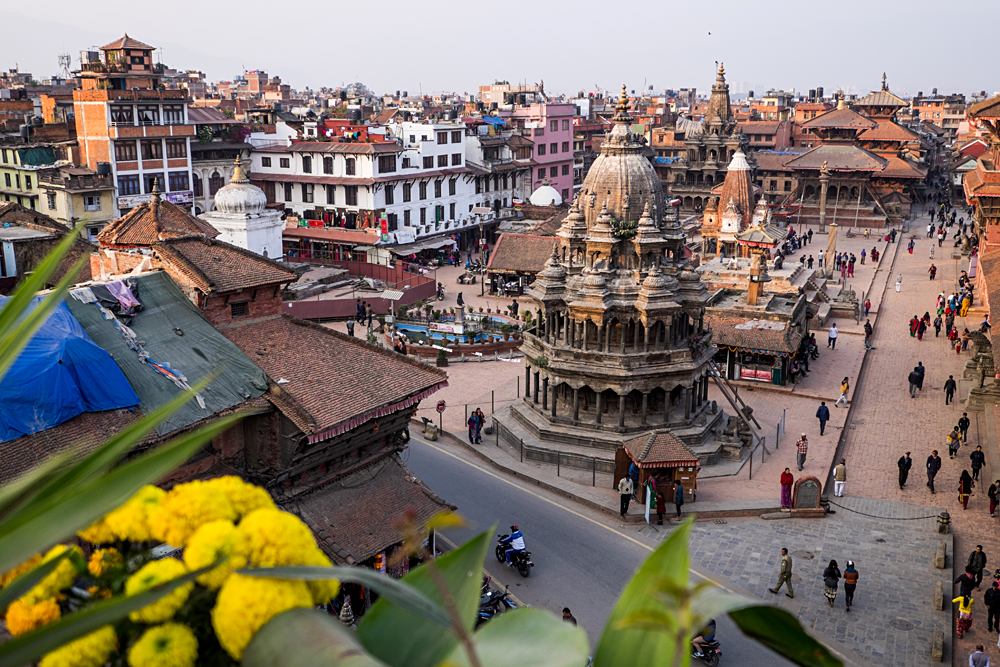
Another important temple is the Jagannath Temple built in the 16th century and known for the erotic figures carved on its wooden struts. The palace itself is divided into two courtyards, the outer and inner. The most important complex in the inner courtyard is the Hanuman Dhoka which was the royal Nepalese residence until the 19th century and was where important ceremonies such as the coronation of the Nepalese king took place. It is possible to visit the state rooms inside this building. It is also home to the King Tribhuwan Memorial Museum which showcases the entire history of this king’s life (1903-1955), and the Mahendra Museum which showcases his son who succeeded him (1920-1972). There are a number of other temples in Durbar Square, but time and space do not allow me to go into all the details.
Something that fascinates me is the very unusual nearby Kumari Chok. It is a gilded cage which contains the Raj Kumari, a girl chosen through a very ancient selection process to become the human incarnation of the Hindu mother goddess, Durga. This girl appears in public during religious festivals and when a fee is paid to her guards!
Bhaktapur Durbar Square is located in the town of Bhaktapur, which is 13 kilometres/8 miles east of Kathmandu. It is a temple complex, again with a combination of different styles of architecture, and has some fine sculptures and woodcarvings. The temples are situated around a palace made of brick and wood. The Bhaktapur Durbar Museum has an exhibition of the traditional art of Nepal such as local products, pottery, etc. Make a visit to the 55 Window Palace, which dates back to the 15th century and features excellent woodcarving. The Art Gallery houses ancient paintings representing the Hindu and Buddhist faiths.
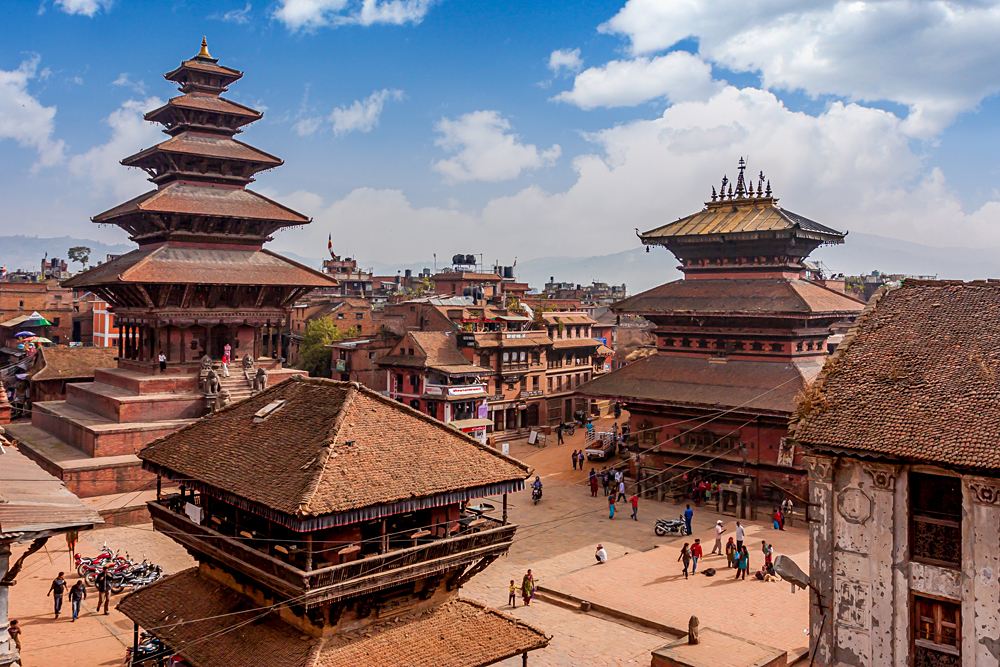
Patan Durbar Square is located in the centre of the city of Lalitpur, 5 kilometres/3 miles south of Kathmandu, in the Kathmandu Valley. The ancient Royal Palace of Patan faces on to this beautiful Durbar Square. The square is full of ancient palaces, temples, and shrines noted for their exquisite carvings. There is a very large and impressive mass of temples, a visually stunning display of what is called Newa architecture, derived by the historic Newari inhabitants of the region. It is the oldest of the three Durbar Squares and was unfortunately heavily damaged during the earthquake that occurred in 2015.
Other important sites around Kathmandu, when on Nepal tours, include the Boudhanath Stupa just outside the city. It is one of the largest stupas of its kind in the world, and dates back to the 5th century, possibly even earlier. It is located 7 kilometres/4 miles east of Kathmandu. Boudhanath has been an important pilgrimage site for centuries. Set on a hilltop to the west of Kathmandu, Swayambhunath is the second most important shrine in the Kathmandu Valley after Boudhanath. Due to the resident monkeys that inhabit parts of the temple, it is also known as the Monkey Temple. The Swayambhu Stupa forms the centrepiece of the temple complex, which dates back to the 5th century.
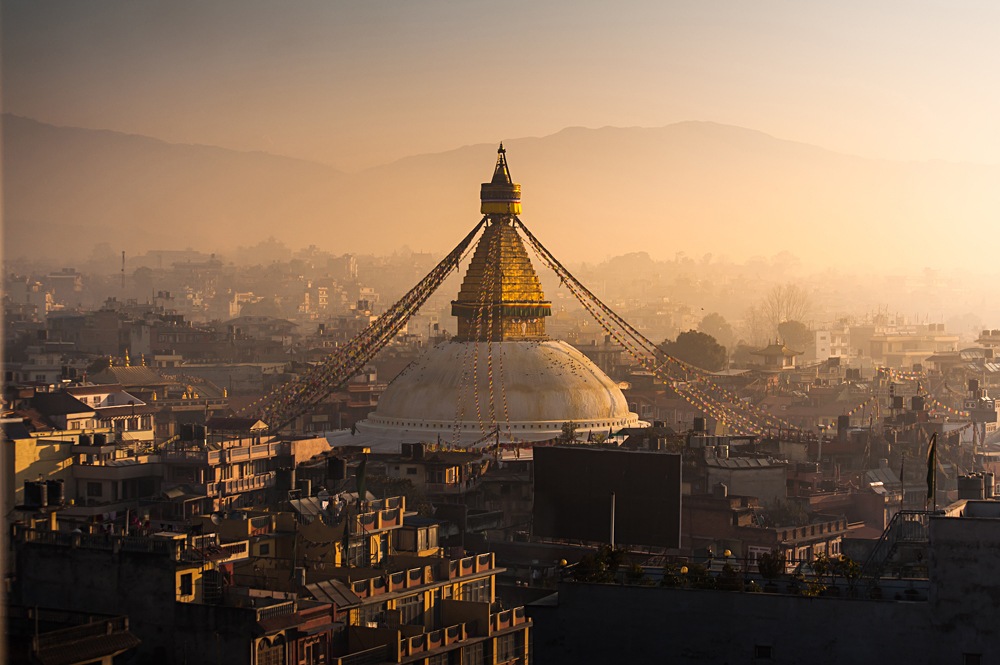
A visit to Dhulikhel, a town 32 kilometres/20 miles south-east of Kathmandu, will reward you in two ways. First, you can enjoy excellent views of the mountains, secondly, you can experience the ancient parts of the town with its atmospheric narrow cobblestone streets and lanes, reminding you of medieval times. There are many interesting temples to see, some of which are still used for worship by the local people. Dhulikhel View Tower, which is up a hill about 1 kilometre/0.5 mile outside the town, offers excellent views of the Himalayas.

Natural Nepal
Nagarkot has a reputation for being the best place to view the Himalayas around Kathmandu. It is 32 kilometres/20 miles away and is a village with hotels from whose balconies you can take in the wonderful mountain vistas. A visit to Nagarkot is best between October and March when you will nearly always be rewarded with mountain views, but be warned, the mountains are notorious for suddenly disappearing behind clouds at any time. If you want to see Mount Everest during a stay in Kathmandu, then take the 45-minute flight excursion from Kathmandu airport. You will experience breathtaking views of not only this mountain peak but the surrounding Himalaya range.

You might think that safaris are something that you only find in Africa. Well, there is a large amount of wildlife in Asia, and Nepal has its fair share. Moving on from Kathmandu and travelling west, Chitwan National Park is the perfect place to enjoy a safari while on Nepal tours. It was established in 1973, has been accorded UNESCO World Heritage status, and is considered one of the best wildlife viewing parks in Asia. It is located roughly in the middle of the country, in the lowland plains. The type of animals that call it home include rhinoceros, leopards, wild elephants, sloth bears, hyenas, wild dogs, mongooses, deer, monkeys, and the Royal Bengal tiger. In total, there are around 70 different species of animals. The park also boasts over 500 different bird species. There is no accommodation inside the park itself but there are luxury lodges just outside the park boundaries, as well as more budget-friendly accommodations a little further way.
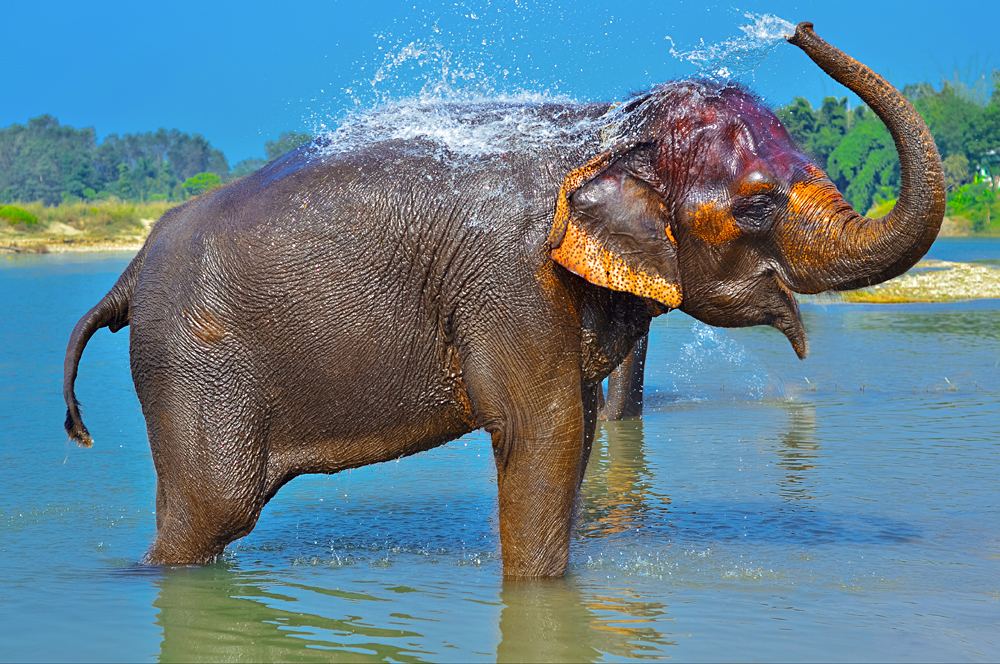
Moving even further west, we come to the beautiful lakeside resort of Pokhara. Phewa Lake is ever present in this resort and is surrounded idyllically by forests and the snow-capped mountain peaks of the Annapurna Range which reflect in its waters. The views of the majestic backdrop of the Himalayas are sensational. You will find a number of hotels, pubs, and bars strung along the shoreline, making it a great place to relax and enjoy the scenery. There are 6 other beautiful lakes in the vicinity of Pokhara which can all be visited and enjoyed. Swimming and boating are two of the main activities. Pokhara has a laid-back charm but it is also a booming adventure sports centre offering paragliding and white-water rafting. You can visit the International Mountain Museum, which is dedicated to historical documents and chronicles about mountaineering, the people living in the Himalayas, plus descriptions of the 14 highest peaks, together with exhibits about famous expeditions. A good place to watch the sunset or the sunrise is at the World Peace Pagoda on top of a hill, just outside of Pokhara.
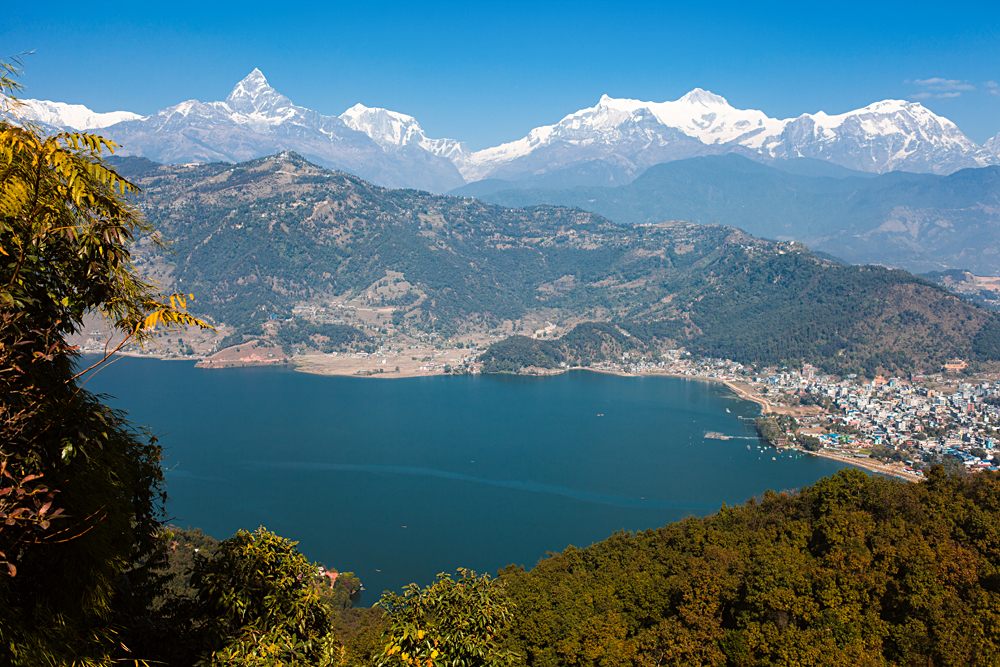
Nepal Trekking
We now come to a very popular pastime on Nepal tours – trekking. Obviously not for everyone, but certainly the country and the scenery make it a very special activity. This can be done from both Kathmandu and Pokhara and treks can be easy or strenuous depending. They can be done stopping overnight at what are called “Tea Houses,” which are basically tourist lodges, or by sleeping overnight in tents. Usually, most trekkers join a group which includes a guide, porters, and full provisions. Treks can be tailored to the individual, ranging from one day to much longer periods of up to at least 3 weeks if so desired. I would say that Pokhara is your best bet to join Nepal treks. This is because of the large number that head to the beautiful Annapurna mountain range. Annapurna itself is the 10th tallest Himalayan peak at 8090 metres/ 26,300 feet above sea level. Treks do not go to the summit, as that then becomes mountaineering. A popular trek is a 14-day round trip to the Annapurna base camp.
You will have heard of the trek to the Everest Base Camp. This is undertaken by flying from Kathmandu to Lukla, which is the start of the trek at 2860 metres/9295 feet. You eventually reach the base camp, which sits at 5380 metres/17,600 feet. On average, the trek takes 8 days to reach the base, and 4 days to descend back down. It is a good idea to spend a little time in the village of Namche, en route, to acclimatize to the altitude. Aside from the breathtaking beauty along the way, you will come across villages and monasteries where you can experience typical Sherpa culture.

Tips on Etiquette
Here are some tips on etiquette when visiting on Nepal tours. Do greet people with a “Namaste,” which is the popular way of greeting when saying hello or goodbye. This is done with your palms together and your fingers pointing up. Don’t do it more than once a day to the same person. I found a definition of Namaste which I like, “The divine in me salutes the divine in you.” Feet are considered dirty, especially the soles of your feet. Always take off your shoes before entering a residential house. The left hand is deemed unclean (I leave it to you to work out why) and therefore, it is considered insulting to touch anyone with your left hand.
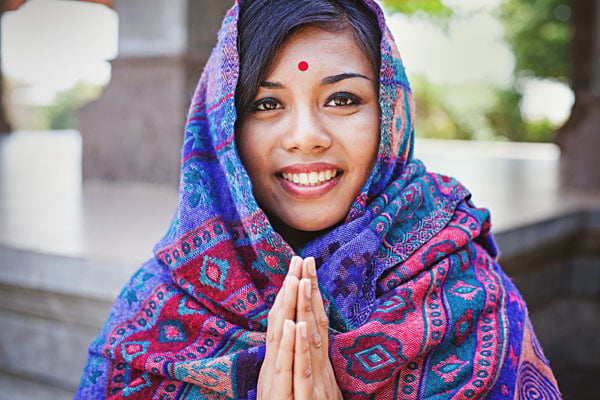
So, there you have the essentials for Nepal tours. It’s a destination just waiting for your visit.
Get more travel inspiration by email.
Subscribe
0 Comments

Get the latest travel trends & hear about the best deals on vacations around the world.
If you’re a Globetrotter, these are the newsletters for you!

